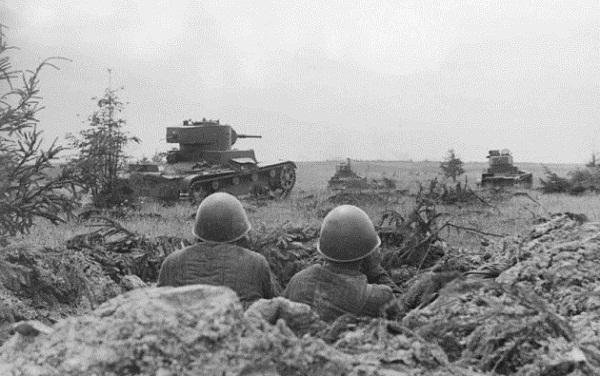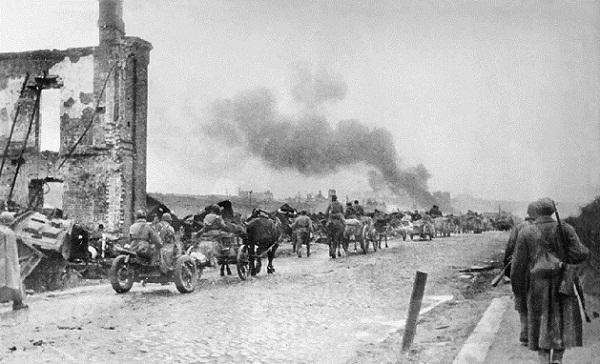In the summer of 1941, against the walls of Smolensk, Hitler’s hopes of holding a brilliant blitzkrieg against the Soviet Union were not destined to materialize. Here German troops belonging to Army Group Center were bogged down for 2 months in battles with units of the Red Army and thereby lost not only time, but also the speed of advancement, as well as the forces that they might need in the future.
The Smolensk battle of 1941 was a whole complex of operations, both offensive and defensive. They were carried out by units of the troops of the Central, Western, Bryansk and Reserve Fronts against the fascist troops included in Army Group Center. The battle of Smolensk took place from July 10 to September 10. The confrontation between the two warring parties took place on a huge territory, covering about 650 km of the front line and deepening about 250 km. The bloody great war began. The battle of Smolensk, I must say, played an important role in it.
German plans
It was the first year of the war. In July, the fascist leadership confronted Field Marshal Theodore von Bock, who was in command of the Army Center units, the most important task. It consisted in the encirclement and further destruction of the Soviet troops that held the defense along the Dnieper and Western Dvina rivers . In addition, German forces were to capture the cities of Smolensk, Orsha and Vitebsk. This would allow them to open a direct path for a decisive attack on Moscow.
Location of Soviet troops
By the end of June, the Soviet command began to rapidly increase the number of Red Army troops along the banks of the Western Dvina and the Dnieper. The task was set: to occupy Polotsk, Vitebsk, Orsha, Kraslava, the Dnieper River and fix these lines. The battle of Smolensk was in no way to prevent the breakthrough of German troops in the central industrial regions of the country, as well as in Moscow. At a depth of about 250 km from the front line, 19 divisions were deployed. Smolensk was also prepared for defense.
On July 10, the troops of the Western Front, commanded by Marshal S. Timoshenko, consisted of 5 armies (37 divisions). And this is not counting the scattered units of Soviet troops retreating from the territory of Western Belarus. But by that time only 24 divisions had arrived at the place of deployment.
Location and number of German troops
The Smolensk battle of 1941 was truly grandiose. This is evidenced by the number of troops that took part in it. While the buildup of Soviet troops was going on, the German command also pulled together the main forces of its two tank groups in the area of the Western Dvina and Dnieper. At the same time, the infantry divisions of the 16th Army, which was part of the units of the North group, occupied a section from Drissa to Idritsa.
As for the two field armies belonging to the Center group, and this is more than 30 divisions, they lagged behind the advanced formations by about 130-150 km. The reason for this delay was fierce fighting in Belarus.
At the time of the outbreak of hostilities, the Germans managed to create some superiority in technology and manpower in the areas of the direction of the main strikes.
The battle of Smolensk in 1941 is conventionally divided into 4 stages. Each of them is very important from the point of view of history.
First stage
It lasted from July 10 to 20. Soviet soldiers at that time only reflected the ever-increasing blows of the enemy, which fell on the right flank and the center of the Western Front. The German tank group of German Goth and the 16th field army, working together, managed to dismember the 22nd and break through the defense of the 19th army located in the region of Vitebsk. As a result of ongoing battles, the Nazis managed to capture Velizh, Polotsk, Nevel, Demidov and Spiritualism.
Having failed, the Soviet units of the 22nd Army strengthened their positions on the Lovati River. So they held the Great Luke. Meanwhile, the 19th, fighting, was forced to retreat to Smolensk. There, she, along with the 16th Army, waged defensive battles for the city.
At this time, the 2nd Panzer Group, commanded by Heinz Guderian, was able to surround part of its forces with Soviet troops near Mogilev. Their main power was thrown to capture Orsha, Smolensk, Krichev and Yelny. Some parts of the Soviet troops were surrounded, others tried to keep Mogilev. Meanwhile, the 21st Army carried out successful offensive operations and liberated Rogachev and Zhlobin. After that, without stopping, she began to advance on Bykhov and Bobruisk. With these actions, she forged significant forces of the 2nd field army of the enemy.
Second phase
This is the period from July 21 to August 7. The Soviet armies who fought on the Western Front received new reinforcements, and immediately went on the offensive in the area of the settlements of Yartsevo, Bely and Roslavl. In the south, the cavalry group, consisting of three divisions, launched its attack on the flank and tried to bypass the main forces of the enemy units belonging to the Army Group Center from the rear. Later Germans joined and lagging formations.
On July 24, the 13th and 21st armies united into the Central Front. Colonel General F. Kuznetsov was appointed commander. As a result of stubborn and bloody battles, Soviet troops managed to disrupt the planned offensive of enemy tank groups, and the 16th and 20th armies escaped from the encirclement with battles. After 6 days, another front was created - the Reserve. Its commander was General G. Zhukov.
Third stage
It lasted from August 8 to 21. At this time, the fighting moved south of Smolensk to the Central, and later to the Bryansk Front. The latter was created on August 16. Lieutenant General A. Eremenko was appointed to command them. Since August 8, units of the Red Army have successfully repelled all attacks by the Germans and their tank group. Instead of stepping on Moscow, the Nazis were forced to confront the units of Soviet troops that threatened them from the south. But, despite this, the Germans still managed to advance inland by about 120-150 km. They managed to wedge between two formations of the Central and Bryansk fronts.

There was a threat of the environment. By decision of the Headquarters, parts of the Southwestern and Central Fronts on August 19 were allotted beyond the Dnieper. The troops of the Western and Reserve, as well as the 43rd and 24th armies began to inflict powerful counterattacks on the enemy in the areas of Yartsevo and Yelny. As a result, the Germans suffered huge losses.
Fourth stage
The final stage of the battle took place from August 22 to September 10. The second German army, together with the tank group, continued to fight with the Soviet units on the Bryansk Front. At this time, enemy tanks were subjected to constant massive airstrikes. More than 450 aircraft took part in these air raids. But, despite this, the advance of the tank group was never stopped. She dealt a powerful blow to the right flank of the Western Front. Thus, the city of Toropets was occupied by the Germans. The 22nd and 29th armies were forced to retreat beyond the Western Dvina.
On September 1, Soviet troops received an order to go on the offensive, but it was not very successful. It was only possible to eliminate the rather dangerous ledge of the Germans near Yelny. And already on September 10, it was decided to stop offensive operations and go on the defensive. Thus ended the battle of Smolensk in 1941.
Defense of Smolensk
Some historians are inclined to believe that the Soviet units left the city on July 16. But the facts show that the Red Army defended Smolensk. This is evidenced by the significant losses that the Germans suffered, trying to break through to the very center of the city and capture it.
To detain enemy troops, July 17, by order of Colonel P. Malyshev, sappers blew up bridges across the Dnieper. For two days there was ongoing fierce street fighting, when many areas of the city several times could pass into one or the other.
Meanwhile, the Germans were building up their fighting power, and in the morning of July 19 they still managed to capture the part of Smolensk, located on the right bank of the river. But the Soviet troops did not intend to surrender the city to the enemy. The Smolensk defensive battle continued on July 22 and 23. During it, the Red Army carried out quite successful counterattacks, and liberated street after street, block after block. In the battle for the city, the Nazis used flamethrower tanks. This technique from its muzzle spewed huge strips of flame, reaching up to 60 m in length. In addition, German aircraft flew continuously over the heads of Soviet soldiers.

Especially fierce battles were fought for the city cemetery, as well as for any of the stone buildings. Very often they grew into hand-to-hand fights, which usually ended in victory for the Soviet side. The intensity of the fighting was so high that the Germans simply did not have time to carry out their dead and wounded from the field.
Of the three Soviet divisions that took part in the defense of Smolensk, each left no more than 250-300 soldiers, and food and ammunition were completely exhausted. And at this time, the combined group under the command of K. Rokossovsky recaptured the settlement of Yartsevo from the Germans, and also captured the crossings across the Dnieper near Soloviev and Ratchino. It was this action that allowed the 19th and 16th Soviet armies to be withdrawn from the encirclement.
The last units of the Red Army left Smolensk at night from July 28 to 29. Only one battalion remained. It was led by senior political instructor A. Turovsky. The task of this battalion was to cover the withdrawal of the main forces of the Soviet troops from Smolensk, as well as simulate the presence of large military units in the city. Fulfilling the order, the survivors switched to partisan action.
Summary
In 1941, the Great Patriotic War only flared up . The battle of Smolensk gave the Red Army commanders that necessary military experience, without which it would be impossible to fight against such an organized and powerful enemy. This confrontation, which lasted 2 months, was the main reason for the disruption of the Hitlerite plan of the blitzkrieg against the Soviet Union.
The significance of the Smolensk battle is hard to overestimate. Thanks to inhuman efforts and heroic actions, as well as the cost of enormous losses, the Red Army managed to stop the enemy and go on the defensive approaches to Moscow. The Soviet units took the brunt of the German tank group, which they wanted to use to capture the second most important city of the USSR - Leningrad.
The Smolensk battle, a photo of the events of which has survived to the present day, has shown that a huge number of soldiers and officers at the cost of their life staunchly and selflessly defended literally every meter of their native land. But do not forget about civilians not only in the city, but also in the region, which provided invaluable assistance in creating defensive positions. About 300 thousand local residents worked here. In addition, they also took part in the hostilities. In the Smolensk region in a short time more than 25 brigades and fighter battalions were formed.